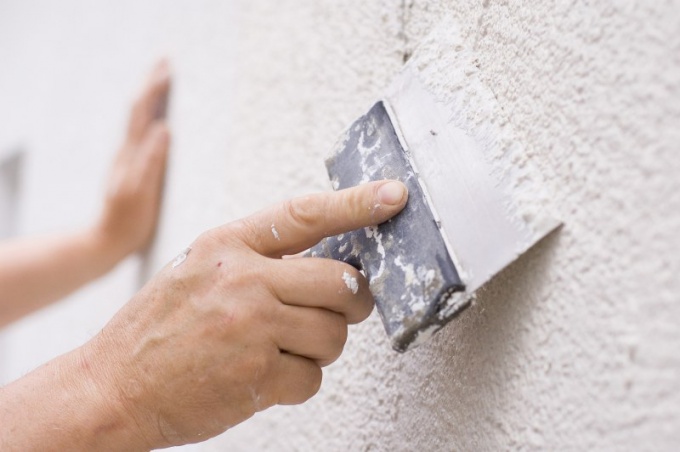How to prepare for plaster, brick and concrete walls
First, brick or a concrete wall should be thoroughly clean from spots, grime, dirt and other types of pollution. These defects can significantly reduce the cohesive strength of mortar of plaster to the surface. Brick, stone and concrete surfaces can be cleaned in a 3% solution of hydrochloric acid. The surface after cleaning should be rinsed with clean water.
The walls are dry heated space of houses and apartments just before carrying out plastering work needs hydration. You can use the soaked in water a paint brush.
To get rid of oil stains on the ceiling and walls, you can use of fat clay. Smear it on affected areas in a thick layer. After that wall surface is dry and clean from clay to absorb fat. If the need arises, this procedure is repeated several times.
However, this method does not give 100% guarantee that oil will not eventually begin to appear again out. And therefore, experts suggest to cut down the grease stains entirely, and the resulting recesses filled with the solution. The surface of the brick wall is cleaned from grout, dirt and dust with a steel brush. Tightly pressing it to the surface, it is driven in different directions.
Before plastering the wall surface with the brush well wetted with water. In that case, if the wall surface is too smooth, roughened at her with an axe or a hammer applied notches, which increase the adhesion of the solution. On a smooth concrete wall incisions are made with hammer or axe. Typically, the length of these incisions is 5-10 cm, and the depth is about 0.5 cm.
To determine the necessary thickness of a layer of plaster, you need to check the plumbness of the walls. For this purpose, the building plumb. On the wall in the area near the ceiling, in the middle and in the corners hammer in nails. Their hat must be in the same plane, in this case, the distance from the nails to surfaces of the brick walls will provide the necessary thickness of a plaster layer at each point.
To achieve an even layer with the help of level (plumb) checked the surface of the walls, after that strongly tense cord is removed beacons-tube. Tubes need to get as more as possible equal stripes beacons from floor to ceiling. Then after setting the strips between them fill the space with mortar.
If the strength of the old stucco coating allows it to apply a levelling layer of new compound, you need to make sure that there are no layers of Wallpaper paste or paint that prevents adhesion of the plaster to the wall. If the wall is cracked, areas of swelling or crumbling material, as well as any other mechanical damage, they must be eliminated.
How to prepare for plaster wooden walls
The rooms of many private houses or flats in old houses separated by wooden partitions. Plaster the wooden surface without prior preparation is not otherwise applied mortar will not stick. First, the surface of wood drunkout - prepare the base to hold the plaster. Lath is a wooden slats of softwood with a cross-section of 5 to 20 mm.
Before applying the plaster green wall should be maintained for at least 1 year. During this period, happens the sludge, and drying of wood surfaces.
Broad wooden surfaces nadkalyvajut, and then drive small wedges in nadkoly. This method prevents the surface from warping, thus preventing cracking of the plaster walls. Dran need to fill in 2 layers.
First layer nailed at intervals of 5-6 cm at an angle of 45 degrees vertically. On top of it at the same angle and with the same frequency, but in the other direction nailed the second layer. The length of the nails should be no more than 30-50 mm.
Formed of a rectangular cell is then filled with a mixture of plaster. After drying it will stay on the surface of the wood wall firmly. Instead of drani it is possible to use a plastic or metal stucco mesh, which are fixed with nails to the surface.
How much is plaster walls
Planning work on the plaster walls, it is important to take into account the financial component. What happens in the end the amount will largely depend on various factors. The cheapest option would be plastering a brick wall. In this case, the price will be around 300-350 $ per square meter. Concrete will cost 400-500 rubles, and the price of the wooden walls in the range of from 500 to 600 rubles per square meter.
The cost also affects the shape of the walls. Work on the circular walls will be 650-750 p. for 1 square meter. Wall material while this cost is not significantly affected. But the thickness of the layer of plaster is already having a big impact on the price. The middle layer of the solution is 1-3 see every inch add on top of the 100 RUB to the cost of 1 sq. meter.
Price for plastering depends on the form of a mixture. The most commonly used cement-sandy, cement-lime and gypsum mixture. There is also decorative plaster. It is used for final finishing of walls, but it is used only for finishing, but not for leveling surfaces.
